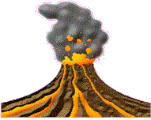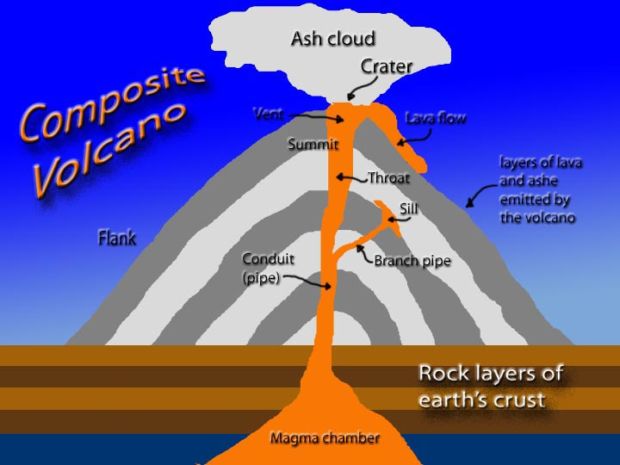|
|
 Volcanoes Volcanoes
What is a Volcano?
 A volcano is a mountain that
opens downward to a pool of molten rock below the surface of the earth. When
pressure builds up, eruptions occur. Gases and rock shoot up through the
opening and spill over or fill the air with lava fragments. Eruptions can cause
lateral blasts, lava flows, hot ash flows, mudslides, avalanches, falling ash
and floods. Volcano eruptions have been known to knock down entire forests. An
erupting volcano can trigger tsunamis, flash floods, earthquakes, mudflows and
rockfalls. A volcano is a mountain that
opens downward to a pool of molten rock below the surface of the earth. When
pressure builds up, eruptions occur. Gases and rock shoot up through the
opening and spill over or fill the air with lava fragments. Eruptions can cause
lateral blasts, lava flows, hot ash flows, mudslides, avalanches, falling ash
and floods. Volcano eruptions have been known to knock down entire forests. An
erupting volcano can trigger tsunamis, flash floods, earthquakes, mudflows and
rockfalls.
Why do volcanoes erupt?
 The Earth's crust is made up of huge slabs called plates,
which fit together like a jigsaw puzzle. These plates sometimes move. The
friction causes earthquakes and volcanic eruptions near the edges of the
plates. The theory that explains this process is called plate
tectonics. The Earth's crust is made up of huge slabs called plates,
which fit together like a jigsaw puzzle. These plates sometimes move. The
friction causes earthquakes and volcanic eruptions near the edges of the
plates. The theory that explains this process is called plate
tectonics.
How many volcanoes are there?
There are more than 1500 active volcanoes on the Earth. We
currently know of 80 or more which are under the oceans. Active volcanoes in
the U.S. are found mainly in Hawaii, Alaska, California, Oregon and
Washington.
What are the different types of volcanoes?
Volcanoes are grouped into four types: cinder cones,
composite volcanoes, shield volcanoes and lava volcanoes.
| Cinder Cones |
Cinder cones are circular or oval
cones made up of small fragments of lava from a single vent that have been
blown into the air, cooled and fallen around the vent. |
Composite
Volcanoes |
Composite volcanoes are
steep-sided volcanoes composed of many layers of volcanic rocks, usually made
from high-viscosity lava, ash and rock debris. Mt. Rainier and Mount St. Helens
are examples of this type of volcano. |
Shield Volcanoes |
Shield volcanoes are volcanoes
shaped like a bowl or shield in the middle with long gentle slopes made by
basaltic lava flows. Basalt lava flows from these volcanoes are called flood
basalts. The volcanoes that formed the basalt of the Columbia Plateau were
shield volcanoes. |
| Lava Volcanoes |
Lava domes are formed when
erupting lava is too thick to flow and makes a steep-sided mound as the lava
piles up near the volcanic vent. The eruption of Mount St. Helens in 1980 was
caused in part by a lava dome shifting to allow explosive gas and steam to
escape from inside the mountain. |
What is the difference between lava and magma?
Magma is liquid rock inside a
volcano. Lava is liquid rock (magma) that flows out of a volcano. Fresh lava
glows red hot to white hot as it flows.
Why does lava take a long time to cool down?
Lava cools slowly because lava is a poor conductor of heat.
Lava flows slow down and thicken as they harden.
What is the largest active volcano?
The world's largest, active volcano is Mauna Loa in Hawaii, where famous coffee is grown in
the rich volcanic soils. Mauna Loa is 13,677 feet above sea level. From its
base below sea level to its summit, Mauna Loa is taller than Mount
Everest.
|
|